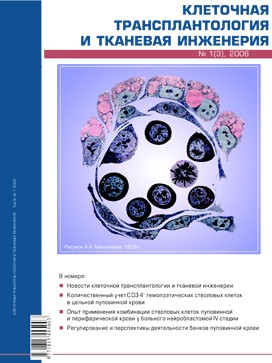Experience of using a combination of umbilical cord and peripheral blood stem cells from partially compatible related donors in a patient with stage IV neuroblastoma
- Authors: Dolgopolov I.S.1, Subbotina N.N.1, Boyarshinov V.K.1, Isaev A.A.2, Andreeva L.Y.3, Demidova I.A.4, Ravshanova R.S.1, Mentkevich G.L.1
-
Affiliations:
- Research Institute of Pediatric Oncology and Hematology of the N.N. Blokhin State Research Center of the Russian Academy of Medical Sciences
- Gemabank
- Research Institute of Clinical Oncology of the N.N. Blokhin State Research Center of the Russian Academy of Medical Sciences
- State Institution of Hematology Research Center
- Issue: No 1 (2006)
- Pages: 78-79
- Section: Clinical experience
- URL: https://genescells.ru/2313-1829/article/view/133629
- DOI: https://doi.org/10.23868/gc133629
- ID: 133629
Cite item
Abstract
Over the past two decades, umbilical cord blood has been recognized as a full-fledged and equal source of hematopoietic stem cells along with bone marrow and peripheral blood. The first transplantation of umbilical cord blood cells from sibling, carried out in 1988 to a child with Fanconi anemia, allowed not only to expand the indications for transplantation, but also deepened our knowledge of the basics of hematopoiesis and the principles of the formation of posttransplantation immunity. An important step was the creation of cord blood banks around the world, which increased the likelihood of finding a suitable donor, and, consequently, had a positive effect on transplant activity. The advantages of cord blood cells are the relative ease of obtaining, high proliferative potential and the "naivety" of the immune system of the transplant. The problems are the small volume and low cellularity of the obtained material, which leads to a delayed recovery of hematopoiesis after transplantation, significantly increases the duration of the patient's stay in the hospital and the need for transfusion of blood products. Attempts are being made to overcome adverse factors by simultaneous transplantation of mesenchymal cells and umbilical cord blood or sequential transplantation of several umbilical cord blood samples from different donors. We present a description of a case of sequential transplantation of umbilical cord blood hematopoietic cells and peripheral stem cells from a related partially compatible donor to a patient with stage IV neuroblastoma.
Keywords
Full Text
About the authors
I. S. Dolgopolov
Research Institute of Pediatric Oncology and Hematology of the N.N. Blokhin State Research Center of the Russian Academy of Medical Sciences
Author for correspondence.
Email: redaktor@celltranspl.ru
Russian Federation, Moscow
N. N. Subbotina
Research Institute of Pediatric Oncology and Hematology of the N.N. Blokhin State Research Center of the Russian Academy of Medical Sciences
Email: redaktor@celltranspl.ru
Russian Federation, Moscow
V. K. Boyarshinov
Research Institute of Pediatric Oncology and Hematology of the N.N. Blokhin State Research Center of the Russian Academy of Medical Sciences
Email: redaktor@celltranspl.ru
Russian Federation, Moscow
A. A. Isaev
Gemabank
Email: redaktor@celltranspl.ru
Russian Federation, Moscow
L. Y. Andreeva
Research Institute of Clinical Oncology of the N.N. Blokhin State Research Center of the Russian Academy of Medical Sciences
Email: redaktor@celltranspl.ru
Russian Federation, Moscow
I. A. Demidova
State Institution of Hematology Research Center
Email: redaktor@celltranspl.ru
Russian Federation, Moscow
R. S. Ravshanova
Research Institute of Pediatric Oncology and Hematology of the N.N. Blokhin State Research Center of the Russian Academy of Medical Sciences
Email: redaktor@celltranspl.ru
Russian Federation, Moscow
G. L. Mentkevich
Research Institute of Pediatric Oncology and Hematology of the N.N. Blokhin State Research Center of the Russian Academy of Medical Sciences
Email: redaktor@celltranspl.ru
Russian Federation, Moscow
References
Supplementary files











